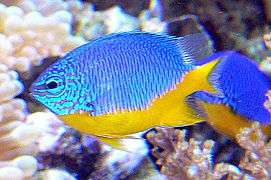Chrysiptera hemicyanea
Chrysiptera hemicyanea, known commonly as the azure damselfish, azure demoiselle, half-blue demoiselle, and yellow-dipped damsel, is a species of damselfish.
| Chrysiptera hemicyanea | |
|---|---|
 | |
| Scientific classification | |
| Kingdom: | Animalia |
| Phylum: | Chordata |
| Class: | Actinopterygii |
| Family: | Pomacentridae |
| Genus: | Chrysiptera |
| Species: | C. hemicyanea |
| Binomial name | |
| Chrysiptera hemicyanea (Weber, 1913) | |
| Synonyms | |
| |
| Wikimedia Commons has media related to Chrysiptera hemicyanea. |
| Wikispecies has information related to Chrysiptera hemicyanea |
Etymology
The generic name, Chrysiptera, is a compound of the Greek words chrysos, meaning "golden" and pteron meaning "fin" or "wing", while the specific name, hemicyanea, means "half blue" referring to the blue head and upper body.[1]
Distribution
It is native to the eastern Indian Ocean and western Pacific.[2] It has also recently been found in the central Mediterranean, in the waters around Sicily and Malta.[3]
Being a reef species, these fish are found in greatest population in whats known as the Coral triangle, which is one of the largest concentrations of coral reefs in the world, located form the Solomon Islands to Indonesia, Bali and the Philippines.[2]
Typically found in waters 1 to 38m deep and are non migratory.[2]
Appearance
This tropical marine fish reaches 7 centimetres (2.8 in) in length. It is mostly bright blue in color, with a bright yellow bottom.[2] Different species in this genus have varied amounts of gold coloring.
Habitat
As a tropical species, these species are found in coral reefs habitats near the equator. They inhabit lagoons or near shore reefs and are typically found in rock structures or around branching corals like Acropora corals.[2] This species is a reef dependent species that needs corals or other structures for protection form predators. Primary eat plankton and small invertebrates.
Reproduction
The reproduction of Chrysiptera hemicyanea is not well studied. Reproduction in the genus Chrysiptera involves mating pairs, followed by a benthic egg laying life cycle, where eggs are adhered to a substrate and a male stays around to guard and aerate the eggs. In addition this genus has a shorter larval stage when compared to other damselfish and because of these two things have issues distributing.[4] Population has the ability to double in 15 months.[2]
Conservation
The primary way to protect this species is to maintain their primary habitat which is coral reefs. In current times coral reefs are beginning to disappear in most areas due to coral bleaching.[5] Coral bleaching occurs when warmer average temperatures cause corals to begin to overheat and die, turning them white. Global warming is though of as the primary cause reef destruction, and will only worsen in the coming decades.[5] It is projected that by the middle of the century there will be severe damage to global coral reefs. As coral reefs die out it may become necessary to supplement structure like artificial reefs or any type of structure that fish has hide in.
In the aquarium
This fish is a popular species in the home aquarium along with some closely related species like Chrysiptera talbotiand C. rollandi. In captivity they are quite hardy and easy to take care of. They can tolerate some minor changes in water chemistry and are recommended for beginners in the saltwater aquarium trade. This species will eat just about anything including fish flakes and frozen brine shrimp.[4]
Even though they are considered a schooling fish, they are quite aggressive and territorial. Fish that invade the area are harassed, sometimes to death. The best way to avoid this is to place fish in a large enough tank with plenty of structure like coral or live rock.[4]
Recently this species has been successfully bred in captivity to try and increase the supply to the aquarium trade and decrease the environmental impact.
References
- Christopher Scharpf & Kenneth J. Lazara (29 August 2018). "Subseries OVALENTARIA (Incertae sedis): Family POMACENTRIDAE". The ETYFish Project Fish Name Etymology Database. Christopher Scharpf and Kenneth J. Lazara. Retrieved 6 October 2018.
- Froese, Rainer and Pauly, Daniel, eds. (2018). "Chrysiptera hemicyanea" in FishBase. June 2018 version.
- "A deluge of alien fish species in Maltese waters". The Malta Independent. 28 June 2017. Retrieved 6 October 2018.
- "Three New Captive Bred Chysiptera Damsels | AquaNerd". aquanerd.com. Retrieved 2018-04-30.
- Milman, Oliver (2017-05-30). "Scientists warn US coral reefs are on course to disappear within decades". The Guardian. Retrieved 2018-04-30.